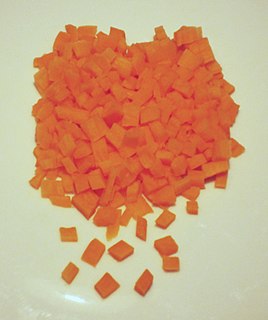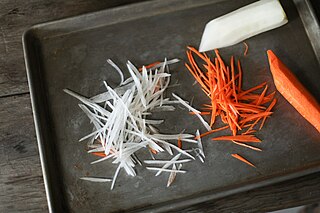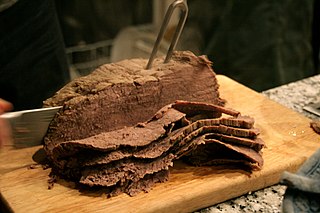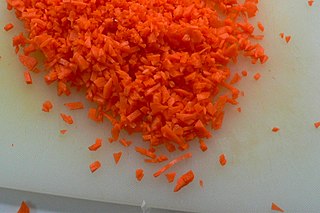 W
WBrunoise is a culinary knife cut in which the food item is first julienned and then turned a quarter turn and diced, producing cubes of about 3 millimetres or less on each side. In France, a "brunoise" cut is a smaller 1 to 2 mm. Some typical vegetables for a brunoise are carrots, celery, leeks, and turnips. The diced vegetables are blanched briefly in salty boiling water and then submerged in salted ice water for a few seconds to set the color. The brunoise is used as a garnish in many dishes; it is often used to garnish consommé. A brunoise should be consistent in size and shape, as this helps to create a pleasing and professional presentation.
 W
WButterflying is a way of preparing meat, fish, or poultry for cooking by cutting it almost in two, but leaving the two parts connected; it is then often boned and flattened. Spatchcocking is a specific method for butterflying poultry that involves removing the backbone, and spatchcock as a noun may refer to a bird prepared in that way.
 W
WChiffonade is a slicing technique in which leafy green vegetables such as spinach, sorrel, or Swiss chard, or a flat-leaved herb like basil, are cut into long, thin strips. This is accomplished by stacking leaves, rolling them tightly, then slicing the leaves perpendicular to the roll. The technique can also be applied to thin crepes or omelets to produce strips.
 W
WCrinkle-cutting is slicing that leaves a corrugated surface.
 W
WDicing is a culinary knife cut in which the food item is cut into small blocks or dice. This may be done for aesthetic reasons or to create uniformly sized pieces to ensure even cooking. Dicing allows for distribution of flavour and texture throughout the dish, as well as a somewhat quicker cooking time. Dicing usually applies to vegetables prepared in this way but it can also apply to the preparation of meat or fish and fruit. Brunoise is an especially small size, produced from further cutting of julienne-style food.
 W
WJulienne, allumette, or french cut, is a culinary knife cut in which the food item is cut into long thin strips, similar to matchsticks. Common items to be julienned are carrots for carrots julienne, celery for céléris remoulade, potatoes for Julienne Fries, or cucumbers for naengmyeon.
 W
WThere are a number of regular knife cuts that are used in many recipes. Each produces a standardized cut piece of food. The two basic shapes for these cuts are the strip and the cube. Strips are generally cut to 2+1⁄2–3 inches (6–8 cm), and are defined by width, from thickest to thinnest as "pont-neuf", "batonnet", "allumette", "julienne", and "fine julienne". The cube shapes, in order from largest to smallest, are the large, medium, and small dice, the brunoise, and the fine brunoise.
 W
WMeat carving is the process and skill of cutting portions of meat, such as roast and poultry, to obtain a maximum or satisfactory number of meat portions, using a carving knife or meat-slicing machine. A meat carver disjoints the meat and slices in uniform portions. Meat carving is sometimes considered a skill for the private dinner table.
 W
WMincing is a food preparation technique in which food ingredients are finely divided into uniform pieces. Minced food is in smaller pieces than diced or chopped foods, and is often prepared with a chef's knife or food processor, or in the case of meat by a specialised meat grinder.